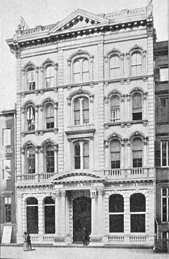steinway Hall
1866-1925
Fourteenth Street • union Square
New YOrk City, NY
USA


steinway Hall
1866-1925
Fourteenth Street • union Square
New YOrk City, NY
USA


The first stones for Steinway Hall building were laid by William Steinway on May 26, 1866, four days after the Academy f Music, located on 14th Street in Manhattan, had burned to the ground. The elegant showrooms of Steinway & Sons, housing more than one hundred pianos, already existed on 14th street between Fifth Avenue and University Place. The ever-increasing popularity of pianos during this era created a demand for the company to expand its showroom. The company’s marketing expert, William Steinway, recognized that it would be good for piano sales if famous piano artists had a place to play on Steinway pianos. With the full support of the City of New York, Steinway constructed the city’s first concert hall , designed to seat an audience of 2,500, its concert stage large enough to fit a full 100-piece orchestra. Built in 1866 behind Steinway’s showrooms, Steinway Hall became the first concert hall in New York City for wider audiences. It was the home of the New York Philharmonic Orchestra for twenty-five years, from 1866-1891, before Carnegie Hall opened in 1891; and, until then, Steinway Hall was not only one of the biggest halls in New York City, but was considered to be one of the cultural centers in America. Illuminated with over 700 gaslights, the ground floor of the building housed the company’s showrooms and office. The first floor held the concert hall, and the remaining two floors had private rooms for piano lessons. William Steinway was also the founder of the Steinway Concert and Artist Department. In 1872, Steinway and Sons organized an unprecedented concert tour with the Russian virtuoso, Arthur Rubenstein, who performed 215 concerts within a 239 days, all of them on a Steinway Concert Grand. Rubenstein’s legendary New York City concert in Steinway Hall was sold out with a standing-room-only crowd of 3,000. The popularity of Steinway Hall attracted performances by the Boston Symphony Orchestra and the master violinist, Fritz Kreisler, whose debut at the age of thirteen took place on the stage of Steinway Hall in 1888. The opera singer, Jenny Lind, also known as the “Swedish Nightingale”, received an enthusiastic reception in New York City when she sang in Steinway Hall, as did the British author, Charles Dickens, who presented readings.
NOTE:
The First Steinway Hall was demolished in 1925 when the Steinway Hall opened its new showroom on 57th Street the same year. This showroom with offices, and its famous piano vault, hosted a long list of famous pianists. Most notably, the celebrated pianists, Vladimir Horowitz and Sergei Rachmaninoff, often met at Steinway Hall to practice together. In 2014, the showroom closed after nine decades. A third Steinway Hall in under construction at this writing and will open in late 2015.
PHOTOS: Left: The interior of Steinway Hall, c. 1890. Right: Exterior of Steinway Hall, an early half-tone photograph printed by Stephen Horgan. in The Daily Graphic December 2, 1973.


The First Concert Hall

